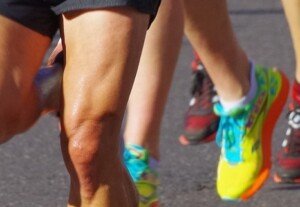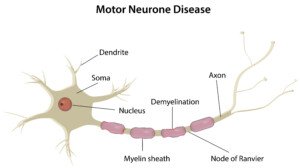
“It can be difficult to distinguish between early ALS atrophy and normal atrophy,” says Bonnie Gerecke, MD, MD, director of the Neurology Center at Mercy in Baltimore.
The typical course goes as follows:
• You notice a muscle has been twitching, such as in the calve, hamstring, chest or eyelid.
• After getting annoyed enough, you google “cause” of twitching muscles.
• ALS sites appear in the search results and grab your attention.
• You begin reading one ALS site after another, and all say that “muscle twitching” is a symptom, but they also say that “muscle atrophy” is a symptom.
• You then begin checking your muscles for signs of atrophy.
• You begin discovering signs of atrophy, such as one calve is bigger than the other, or there’s a “dent” in the front of your thigh.

Benign thigh dents take on a variety of forms.
Atrophy means shrinkage of muscle due to disuse. This happens in healthy people all the time, and can be quite noticeable depending on the circumstances.
We’ve all seen the atrophy of a limb after a cast for a broken bone, that’s been in place for weeks, is finally removed.
Telling the Difference Between ALS Atrophy and Benign
“Early ALS atrophy may be more focal,” says Dr. Gerecke.
“This means that it may start in a specific muscle group, such as the small muscles of the hand,” continues Dr. Gerecke.
“It then spreads to affect other muscles of the same limb, for example.”
So for instance, ALS may begin in the foot, then locally spread, being confined to the lower leg.
Eventually the other side of the body will become affected, most likely beginning with the opposite foot and lower leg.
ALS atrophy does not strike the entire body at the same time. It begins very locally.

Shutterstock/joshya
Dr. Gerecke explains, “Normal atrophy such as that associated with aging tends to be more symmetrical and diffuse.”
But what if you notice local atrophy?

Well, here’s the thing about this. You must ask yourself what proof you have that what you’re seeing is actually shrinkage of muscle.
If you frantically inspect your body in the mirror, you just might find what you’re looking for: signs of atrophy – or rather, what you THINK are signs, such as:
• One calve is smaller than the other.
• There’s a depression of skin below the right collarbone but not the left.
• One foot is slightly larger than the other.
• One forearm is smoother than the other.
• The veins in the top of one foot are more visible than in the other.
• One thigh has a dent.

Shutterstock/Motortion Films
You even confirm some of the size differences with a measuring tape. You’re convinced you have localized atrophy.
Dr. Gerecke says, “Normal atrophy is also not as pronounced as pathological atrophy associated with ALS.”
You may be thinking that ALS, like any degenerative disease, starts out very small; that it has a very early stage – and that during this stage, the atrophy would actually not be pronounced.
But if it’s ALS, it won’t be long before the wasting becomes increasingly obvious – and accompanied by weakness.
In fact, the weakness will very likely come before visible signs of muscle shrinkage.
So you have to keep reminding yourself of a few things:
• If you’re healthy, time passage will become very reassuring, since in a healthy body, there is no progression of visible or functional pathology.
• Parts of your non-dominant limbs are bound to be noticeably smaller than the dominant ones, but smaller doesn’t necessarily mean atrophied due to less use.
• You may find that your non-dominant left lower leg is smaller than your right, but that it’s also the leg you jump off of when doing single-leg jumps across a water puddle, and that your right leg was never the better one at leaping.
• The body is naturally asymmetrical. There are dips, dents and depressions on one side that are not on the other.
You’re not a Greek statue. You’re imperfect. There’s going to be asymmetry!
So though the visible distinction between early ALS and benign atrophy may be difficult to tell, just hold tight and realize that you are, from a statistical standpoint, panicking for no reason whatsoever.
Let time passage work its wonders on you.

Dr. Gerecke has a special interest in ALS, myasthenia gravis, myopathy/muscular dystrophy, peripheral neuropathy and radiculopathy. She is board certified in general neurology and neuromuscular medicine.
 Lorra Garrick has been covering medical, fitness and cybersecurity topics for many years, having written thousands of articles for print magazines and websites, including as a ghostwriter. She’s also a former ACE-certified personal trainer.
Lorra Garrick has been covering medical, fitness and cybersecurity topics for many years, having written thousands of articles for print magazines and websites, including as a ghostwriter. She’s also a former ACE-certified personal trainer.
.
Top image: Shutterstock/BLACKDAY
ALS Anxiety, Muscle Atrophy and Twitching Conquering This Stress


























